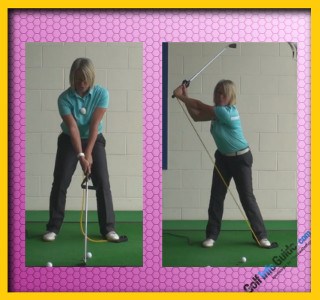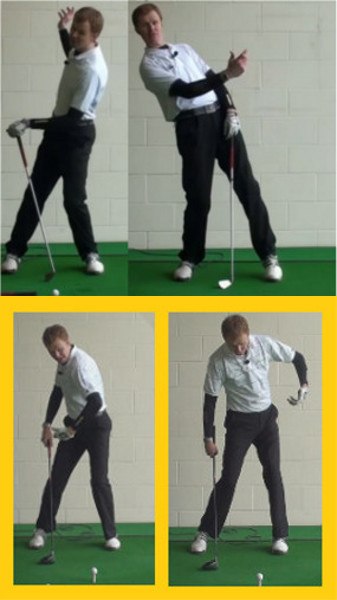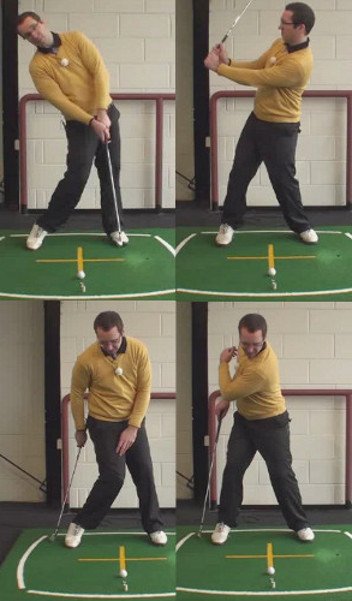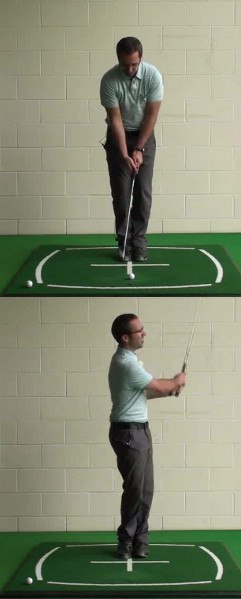
If you have a reverse pivot problem in your golf swing, as you swing the golf club back away from the ball on your backswing, you will incorrectly put more weight on to your left foot at the top of your backswing (for a right handed golfer).
This will result in a spine angle where the upper part of your spine is closer to the target than the lower part of your spine and again this is an incorrect position. The result of this position at the top of your backswing will be that you either making a chopping action with the golf club down towards the ball and strike the top of the ball into the floor producing a low shot with little power, or you will try to correct the position and your weight will move back on to your right foot as you swing down towards the ball, which will result in you leaning to the right with your body as you hit, making you strike the ground before the ball or just skim over the ground and catching the ball as you swing upwards, again hitting the top of the ball. Either way, a reverse pivot makes it very difficult to strike the ball consistently well or with any power.
To correct this position at the top of your backswing, try this drill. Set up ready to hit the golf ball. Imagine you have a friend standing to the right of you, in line with you but with a waist height fence between you. Reach out to them with your left hand as though you were going to shake their hand over the fence. This movement will now put you into a position where you have transferred your weight on to your right foot and moved your upper spine slightly over to the right of your lower spine, which is the correct position to be in.
Similarly, you could hold a resistance band in your hands as though it were your golf club. Place the other end of the band under your left foot and stretch the band away to your right as you make your backswing, holding it out away from you.
This will also create the same position where you have moved your weight over to your right foot and your upper spine to the right of your lower spine as you have rotated your shoulders 90 degrees to the right.

Fix Reverse Pivot Problems with Practice Drills
The reverse pivot is one of the biggest problems in amateur golf. Countless amateur players have a reverse pivot in their golf swing, and they struggle to play quality golf as a result. While it isn't necessarily impossible to hit a good shot using a reverse pivot, this awkward move certainly does make the game more difficult than it needs to be. Those who reverse pivot during the swing will always be giving away potential power, and they will struggle to make clean contact through the hitting area. In all likelihood, you will be well-served to take the reverse pivot out of your golf swing as soon as possible.
Before we get too far into the discussion of how to get rid of the reverse pivot, we should take a few moments to define this swing mistake. You have probably heard this term tossed around in golf circles before, but you might not know exactly what it means. Simply put, a swing with a reverse pivot is one where the golfer's weight moves toward the target during the backswing and away from the target in the downswing. For a right-handed golfer, that means the weight moves onto the left foot in the backswing and then shifts over to the right foot as the club swings down. This is not the proper way to swing the club, and it will lead to a variety of problems.
In a fundamentally sound golf swing, the weight will remain mostly balanced between the two feet in the backswing before shifting toward the target as the club swings down. While there shouldn't be much weight shift during the backswing phase, any shift that does take place should be moving away from the target. Of course, this concept makes sense on a basic level. If you are trying to hit the ball toward a target well off in the distance, you should be moving toward that target as you swing. Moving toward the target, along with the club, will help you deliver the most powerful blow possible into the back of the ball. If you are moving back away from the target while trying to swing forward, it only stands to reason that your swing is going to come up short of its potential.
We are going to hope to accomplish a couple of goals with the content below. First, we are going to determine whether or not you have a reverse pivot in your swing. After all, there would be no sense in trying to fix a reverse pivot move that doesn't exist in the first place. If you do find that you are guilty of a reverse pivot, the remainder of the article will provide you with some practice drills which can help you correct your weight shift problem. If you are able to successfully remove the reverse pivot from your game, you should be able to look forward to longer and straighter golf shots in the relatively near future.
All of the content below has been written from the perspective of a right-handed golfer. If you happen to play left-handed, please take a moment to reverse the directions as necessary.

The Telltale Signs
A good golfer has to think like a detective. You should constantly be looking for 'clues' in your game to indicate that something may be wrong with your technique. For example, if you are regularly pulling the ball to the left of the target – even when you feel like you have made a good swing – there is likely a mechanical issue which needs to be addressed. As your golf swing is certain to change over time, you must watch for new clues regularly in order to make adjustments as quickly as possible.
So, what kinds of clues should you be looking for when concerned about a reverse pivot? The following list includes some of the telltale signs of this weight transfer error.
- Deep divots. Players who use a reverse pivot tend to swing down steeply into the ball, creating deep divots even with their longer clubs. If you notice that you are taking big chunks out of the ground with each shot you hit, or if you notice that your divots have suddenly gotten deeper in recent weeks, you might have a reverse pivot in your swing. Of course, this point alone shouldn't be considered as conclusive proof, as it is possible to take deep divots without a reverse pivot. Swinging down too steeply into the ball is a problem because of an elevated backspin rate and difficulty making clean contact, so you want to make the necessary adjustments right away to flatten out your path.
- Shots starting to the left of the target. It is typical for the reverse pivot to be accompanied by an over-the-top move during the transition from backswing to downswing. When that happens, the club ends up higher than it should be to start the downswing, and you will be forced to swipe across the ball from outside-in as a result. When you hit across the ball at impact, there are two likely outcomes – a pull to the left, or a shot which starts left before slicing back to the right. Either way, you will struggle to play good golf with these ball flights, as you will have almost no chance to consistently send the ball toward the target.
- Lack of distance. If you are consistently the shortest hitter in your group despite having similar physical capabilities as the rest of the players, you may be wasting power through the use of a reverse pivot. This move often leaves golfers feeling confused about their lack of power, as even their best swings fail to produce much in the way of club head or ball speed. Think about the last few rounds you have played – are you always the shortest hitter by a significant margin? If so, there may be a problem with the way you are using your weight during the swing.
The three points listed above make up the main symptoms you will notice when a reverse pivot makes its way into your game. These issues may be relatively minor if you are only making a slight reverse pivot, or they could be dramatic if your weight shift issue is significant. Either way, you need to get right to work on correcting this error if you hope to play better golf in the near future.
If one or two – or all three – of the signs above are present in your game at the moment, there is a good chance you are guilty of a reverse pivot. However, you don't want to assume that a reverse pivot is present just because of these points. After all, it is possible that you are making other mistakes which could be leading to the trouble you are experiencing in your game. So, before moving on to the drills below, it would be a good idea to record your swing on video to see any weight shift problem for yourself. Ask a friend to record a video of your swing on the driving range and then watch that recording back for yourself. If you see your weight moving toward the target in the backswing and away from it in the downswing, you will know conclusively that you have a problem which needs to be fixed.

Drill #1 – Left Heel Up
The first drill we are going to suggest may be the most effective drill of all for players dealing with a reverse pivot. This drill is easy to use, and it can be performed with any of your clubs. During your next trip to the practice range, follow the steps below to work on implementing a proper weight shift in your swing.
- To get started with this drill, you are going to do everything just as you would during any other practice session. You will need to have a bucket of practice balls available, you will need to pick a club, and you will need to pick a target. For the club, it is best to start with something like a six or seven iron, although you can technically use any club you wish. Those mid-irons offer a nice blend of distance and control, giving you a good chance to make solid contact while adjusting to your new balance. Of course, pick a target based on the club you are going to use, and be sure to aim carefully at your target prior to every swing.
- When you have the preliminary steps completed, you can walk up to the ball and take your stance for the first shot. Settle in to your stance just as you would for any normal shot on the driving range, making sure to flex your knees properly. Also, be sure to keep your chin up off of your chest to allow room for your shoulders to rotate in the swing.
- Before you start the swing, you are going to make one last-second adjustment to your setup – you are going to lift your left heel up off the ground. You don't want to go all the way up onto the toe of your left shoe, but you should get onto the ball of your foot while the left heel is clear of the turf. While you are going to make an adjustment to your left foot to start the swing, your right foot should remain flat on the ground.
- Once your left heel is up, go ahead and start the swing. From address all the way up to the top of the backswing, you need to continue to hold your left heel off the turf. To do so, you are going to have to break the habit of moving your weight to the left during the backswing. Since your whole right foot is still on the ground, it will be more comfortable to keep your weight on that side. Your feet should look the same at the top of the swing as they did at address – right foot flat on the turf, with the left heel up off the ground.
- As your swing transitions down toward the ball, you are going to move your left heel back toward the ground while allowing your weight to shift toward the target. You should be rotating to the left aggressively at this point, which will naturally pull your weight onto your left side. Swing through the shot, keep your head down through impact, and do your best to hold a balanced finished as you watch the ball fly toward the target.
Feel free to repeat this drill as many times as you would like, with a variety of different clubs. The beauty of this drill is found in its simplicity – you are making normal golf swings with only one minor adjustment. Also, you need no specialized equipment to perform this drill, meaning you can do it during any practice session. In fact, if the reverse pivot issue continues to plague you, it is possible to use this as a practice swing drill out on the course before hitting your shots. If you regularly use this drill, and you execute it correctly, you may find that your reverse pivot is quickly a thing of the past.

Drill #2 – Feet Together
One of the misconceptions held by many amateur golfers is the thought that there needs to be a significant weight shift in the golf swing from side to side. Yes, your weight is going to move during the swing, but that movement should be a result of the rotation you use to hit the shot. If you are intentionally sliding from side to side as you swing, you will never be able to produce consistently powerful shots. With this drill, you are going to move your feet together in order to take away all of the lateral movement in your swing.
With a wedge in your hands, set up on the practice range to hit a few shots. Pick a target for these shots which is quite close to where you are standing – the target should be no more than 50 yards away. Once you have picked a target, take your normal stance as if you were going to play this shot out on the course. However, prior to starting your swing, you are going to move your feet together to where there is only an inch or two between your shoes. This will feel rather uncomfortable at first, but hit a few shots from this position. You will quickly notice that you need to make a great shoulder turn and use a full release in order to hit solid wedge shots with this setup.
You don't want to hit longer shots while using this drill because having your feet so close together is not going to allow you to use your lower body properly in a longer swing. It does work nicely for short swings however, and the lesson you learn here will be helpful in getting rid of the reverse pivot. After you have hit a few shots with your feet together, move back to your regular stance and hit a few more. With any luck, you will immediately notice a difference in your ability to stay balanced throughout the swing.

Drill #3 – Swing in Reverse
This final drill is a great one to use if you don't always have access to a driving range to practice your swing. Since you aren't going to be hitting any balls in this drill, you don't have to be at the course to squeeze in a few minutes of work on your technique. As long as you have a space with enough room to safely make some practice swings, you will be able to perform this drill. Of course, you will need to have access to a golf club as well – in this case, you can use any club you like.
To complete this drill properly, please follow the steps below.
- Pick up the club you have chosen to use for this drill and take a stance just as you would on the course. Even though you aren't going to be hitting any shots, it might be helpful to select an imaginary target in the distance just to orient your stance.
- With your stance complete, you are now ready to begin the drill. However, rather than swinging back as you would do normally, you are actually going to swing forward from address to move directly up into your finish position. When you arrive at that finish position, make sure to have the majority of your weight on your left side, while your right heel is completely up off the ground. Hold this position for at least a few seconds before moving on to the rest of the drill.
- From your finish position, you are now going to 'unwind' your swing back down toward address. In fact, you are going to continue on from there in order to perform the entire swing in reverse. Move backward through the hitting area, up toward the top of the backswing, and then back down again to address. As you complete this backward swing, pay attention to your balance at all times. You should be controlling your weight as you go, using mostly rotation to move the club around your body.
- Repeat the process of making a reverse swing as many times as you would like. When you are finished with the drill, make a few traditional swings while continuing to focus on good balance.
What does this drill have to do with fixing your reverse pivot? By swinging in reverse, you will be aware of every small movement that is made by your body, since you will not be accustomed to moving in this manner. Even though the swing is backward, you will still learn a lot about how your weight is supposed to be positioned at various points in the swing. When you go back to swinging normally, those lessons should help you ditch the reverse pivot once and for all.
It is possible that you will only need to use one of the three drills offered in this article in order to fix your reverse pivot problem. The first drill is particularly effective, so you would be well-served to start there and then proceed as necessary. However, no matter which of the drills you decide to use, you should be aware that it is very likely you will need to spend considerable practice time on this point before you can break this habit. Your reverse pivot may be a problem which has been developing for months or even years, meaning you shouldn't expect to break it in just a few short minutes. Only with consistent practice and effort will you be able to separate yourself from this frustrating mistake.
When you feel that you have made progress on your reverse pivot, go ahead and book a tee time to test your new and improved swing out on the course. Even if you are hitting the ball beautifully on the range, be careful not to expect too much from yourself right away during your first round. It is going to take some time to adjust to your new swing under 'game' conditions, so there are likely to be a few hiccups along the way. Stick with it, be optimistic about your future, and don't fall back into old habits at any point along the way.
The reverse pivot is a swing mistake that costs countless golfers the ability to hit longer and straighter shots. If you are making a reverse pivot in your own swing at this time, consider using the drills included above to get things back on track. Improvement on this point is going to take time and dedication, but your efforts will be rewarded in the end. Once your golf swing is free from the reverse pivot, lower scores will quickly come into view. Good luck!






